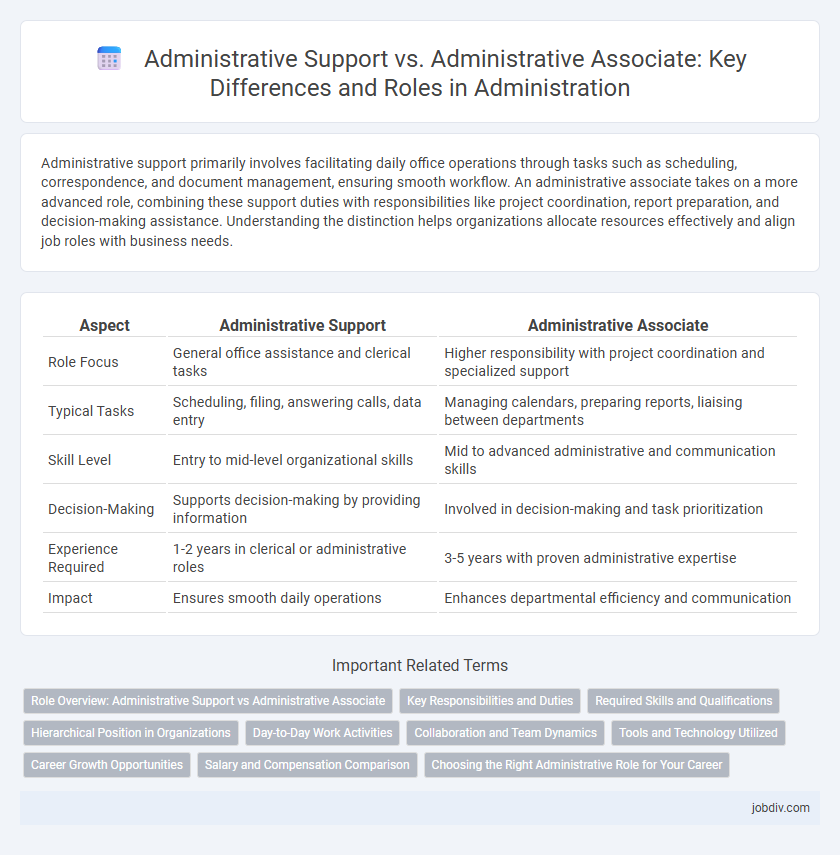Administrative support primarily involves facilitating daily office operations through tasks such as scheduling, correspondence, and document management, ensuring smooth workflow. An administrative associate takes on a more advanced role, combining these support duties with responsibilities like project coordination, report preparation, and decision-making assistance. Understanding the distinction helps organizations allocate resources effectively and align job roles with business needs.
Table of Comparison
| Aspect | Administrative Support | Administrative Associate |
|---|---|---|
| Role Focus | General office assistance and clerical tasks | Higher responsibility with project coordination and specialized support |
| Typical Tasks | Scheduling, filing, answering calls, data entry | Managing calendars, preparing reports, liaising between departments |
| Skill Level | Entry to mid-level organizational skills | Mid to advanced administrative and communication skills |
| Decision-Making | Supports decision-making by providing information | Involved in decision-making and task prioritization |
| Experience Required | 1-2 years in clerical or administrative roles | 3-5 years with proven administrative expertise |
| Impact | Ensures smooth daily operations | Enhances departmental efficiency and communication |
Role Overview: Administrative Support vs Administrative Associate
Administrative Support professionals primarily handle routine clerical tasks such as scheduling, data entry, and managing correspondence to facilitate smooth office operations. Administrative Associates perform more specialized functions including project coordination, report preparation, and direct support to management, often requiring higher levels of decision-making and organizational skills. Both roles are essential for operational efficiency, but Administrative Associates typically engage in more complex responsibilities and strategic administrative duties.
Key Responsibilities and Duties
Administrative Support primarily handles clerical tasks such as managing correspondence, scheduling appointments, and maintaining filing systems to ensure smooth office operations. Administrative Associates perform similar duties but often take on more specialized responsibilities, including project coordination, data analysis, and direct communication with clients or senior management. Both roles demand proficiency in organizational tools, but Administrative Associates typically require a higher level of autonomy and decision-making skills.
Required Skills and Qualifications
Administrative Support roles typically require proficiency in office software such as Microsoft Office Suite, strong organizational skills, and effective communication abilities to manage scheduling, correspondence, and clerical tasks efficiently. Administrative Associates often need advanced qualifications, including experience with project management tools, data analysis capabilities, and knowledge of specific industry regulations or company policies. Both positions demand attention to detail, multitasking proficiency, and a customer service-oriented approach to support executive teams and streamline daily operations.
Hierarchical Position in Organizations
Administrative Associates typically hold entry to mid-level positions within organizational hierarchies, providing specialized support to departments or teams. Administrative Support roles often encompass broader, more foundational tasks and may occupy lower hierarchical levels, focusing on routine clerical duties. The distinction in hierarchical position reflects varying scopes of responsibility and decision-making authority between Administrative Associates and general Administrative Support staff.
Day-to-Day Work Activities
Administrative Support primarily handles routine clerical tasks such as scheduling appointments, managing correspondence, and maintaining office supplies to ensure smooth daily operations. Administrative Associates often take on more specialized responsibilities including preparing reports, coordinating projects, and supporting management with complex administrative functions. Both roles are integral to organizational efficiency but differ in scope and complexity of day-to-day work activities.
Collaboration and Team Dynamics
Administrative Support professionals enhance collaboration by managing schedules, coordinating communication, and facilitating information flow across teams, ensuring seamless operations. Administrative Associates actively participate in team dynamics by handling specialized tasks, contributing to project execution, and supporting decision-making processes. Both roles foster a productive work environment through effective teamwork and clear communication channels.
Tools and Technology Utilized
Administrative Support professionals typically utilize office software suites such as Microsoft Office or Google Workspace, along with communication tools like email platforms and scheduling applications to efficiently manage daily tasks. Administrative Associates often leverage advanced project management software, customer relationship management (CRM) systems, and specialized databases to coordinate workflows and maintain detailed records. Both roles depend heavily on collaboration tools like Slack or Microsoft Teams to facilitate seamless communication and task tracking within organizations.
Career Growth Opportunities
Administrative Associates often have broader responsibilities compared to Administrative Support roles, which enhances their skill set and increases eligibility for higher-level positions. Career growth opportunities for Administrative Associates include stepping into specialized roles such as office management or human resources, driven by their experience managing complex tasks. Administrative Support roles typically offer a solid foundation but may require additional training or education to advance beyond entry-level positions.
Salary and Compensation Comparison
Administrative Support roles typically offer entry-level salaries ranging from $30,000 to $45,000 annually, emphasizing routine clerical tasks and foundational office assistance. Administrative Associates command higher compensation, often between $45,000 and $60,000 per year, reflecting advanced responsibilities such as project coordination and specialized administrative functions. Salary variations depend on factors like geographic location, industry sector, and years of experience, with Administrative Associates generally positioned for better financial growth and added benefits packages.
Choosing the Right Administrative Role for Your Career
Choosing between an Administrative Support and an Administrative Associate role depends on your career goals and skill set. Administrative Support positions typically involve handling routine clerical tasks such as data entry, scheduling, and document management, ideal for entry-level professionals seeking foundational experience. Administrative Associate roles often require advanced skills in project coordination, communication, and independent decision-making, making them suitable for those aiming to develop leadership qualities and greater responsibility in administrative functions.
Administrative Support vs Administrative Associate Infographic

 jobdiv.com
jobdiv.com